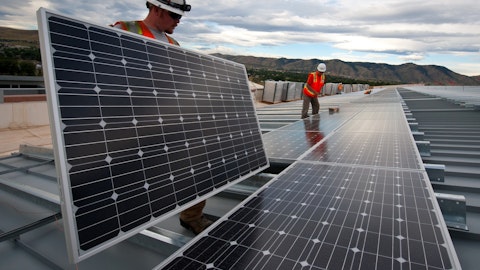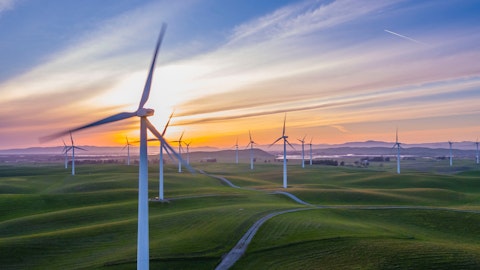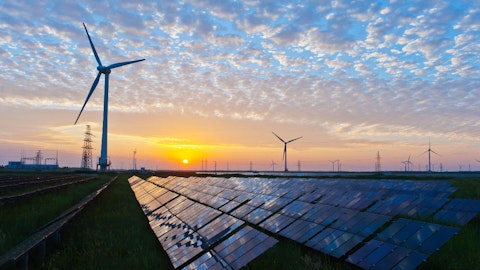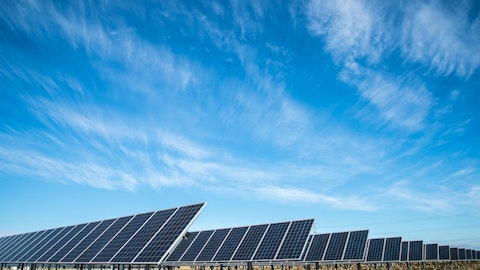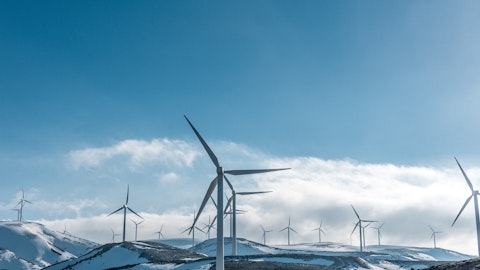Canadian Solar Inc. (NASDAQ:CSIQ) Q4 2022 Earnings Call Transcript March 21, 2023
Operator: Ladies and gentlemen, thank you for standing by. Welcome to Canadian Solar’s Fourth Quarter 2022 Earnings Conference Call. My name is Rob, and I’ll be your operator for today. As a reminder, this conference is being recorded for replay purposes. I would now like to turn the call over to Isabel Zhang, Investor Relations Director at Canadian Solar. Please go ahead.
Isabel Zhang: Thank you, operator, and welcome, everyone, to Canadian Solar’s fourth quarter 2022 conference call. Please note that we have provided slides to accompany today’s conference call, which are available on Canadian Solar’s Investor Relations website within the Events and Presentations section. Joining us today are Dr. Shawn Qu, Chairman and CEO; Yan Zhuang, President of Canadian Solar’s majority-owned subsidiary, CSI Solar; Dr. Huifeng Chang, Senior VP and CFO; and Ismael Guerrero, Corporate VP and President of Canadian Solar’s wholly-owned subsidiary, Global Energy. All committee executives will participate in the Q&A session after management’s formal remarks. On this call, Shawn will go over some key messages for the quarter.
Yan and Ismael will respectively review the highlights of the CSI Solar and Global Energy businesses, followed by Huifeng, who will go through the financial results. Shawn will conclude the prepared remarks with the business outlook, after which we will have time for questions. Before we begin, may I remind listeners that management’s prepared remarks today as well as their answers to questions will contain forward-looking statements that are subject to risks and uncertainties. The company claims the protection of the safe harbor for forward-looking statements that is contained in the Private Securities Litigation Reform Act of 1995. Actual results may differ from management’s current expectations. Any projections of the company’s future performance represent management’s estimates as of today.
Canadian Solar assumes no obligation to update these projections in the future unless otherwise required by applicable law. A more detailed discussion of the risks and uncertainties can be found in the company’s annual report on Form 20-F filed with the Securities and Exchange Commission. Management’s prepared remarks will be presented within the requirements of SEC Regulation G regarding generally accepted accounting principles or GAAP. Some financial information presented during the call will be provided on both a GAAP and a non-GAAP basis. By disclosing certain non-GAAP information, management intends to provide investors with additional information to permit further analysis of the company’s performance and underlying trends. Management uses non-GAAP measures to better assess operating performance and to establish operational goals.
Non-GAAP information should not be viewed by investors as a substitute for data prepared in accordance with GAAP. And now I would like to turn the call over to Canadian Solar’s Chairman and CEO, Dr. Shawn Qu. Shawn, please go ahead.
Shawn Qu: Thank you, Isabel, and hi, everyone. Welcome, and thanks for joining us on our call today. Please turn to Page 3. 2022 was a record year for Canadian Solar in terms of revenue and profit. We grew revenue by 42% to a record $7.5 billion, and we grew net income attributable to shareholders by 152% to a record $240 million. Diluted earnings per share for 2022 was $3.44. I would like to thank both our CSI Solar and Global Energy teams for their focus and outstanding work in achieving these results. Before turning the call over to Yan, Ismael and Huifeng, I would like to give you a higher level view of what we are seeing. Please turn to Page 4. If you look at our key financials between 2015 to 2020, you will notice limited revenue and earnings growth as the massive increase in volume was offset by the huge decline in costs and ASP in solar modules.
During that period, we put in place strict cost control efforts and invested in R&D to reduce our manufacturing costs while improving our product efficiency and output. This financial discipline and technology focus helped us achieve the critical goal of great parity and helped make clean energy investments attractive without government subsidies. Today, solar energy is a good investment both economically and from a sustainability standpoint. This has unlocked a much greater pool of global demand and attracted significant amount of capital into this space. As an integrated manufacturer and a developer, the closer we reached the bottom of the cost curve, the closer we are to translating volume growth into both revenue and earnings growth. If you look at the past two years, raw material costs increased meaningfully due to COVID-related reasons.
Recently, some of the raw material costs have started to decline, such as that of polysilicon as the new capacities ramp up. But we are not quite at the bottom of the cost curve yet, given the technological innovation in the pipeline that will help us achieve further efficiency gains and cost declines. The key point is that we are getting very close to the bottom of the cost curve; at which point, value and technology differentiation will become the predominant drivers of profitability, not cost. With that, we expect to see greater pricing power and operating leverage as our cost structure stabilizes further, and the world continues to invest in cleaner energy infrastructure and secure universal access to energy. I think our company and our industry are at a critical turning point and is worth watching very closely.
Please turn to the next slide. Before turning the call over to Yan, I want to update you on CSI Solar’s carve-out IPO in China. This morning, we received the approval for the registration with the China Securities Regulatory Commission. Our auditors are in the process of fully auditing CSI Solar’s 2022 financials, and we will update our prospectus once the 2022 financial auditing is completed. Given today’s update, we think we are on track to complete the IPO in Q2 of this year. With that, let me now turn to Yan who will provide more details our CSI Solar business. Yan, please go ahead.
Yan Zhuang: Thanks, Shawn. Please turn to Slide 6. As Shawn noted, 2022 was a record year for us. We grew solar module shipment 45% year-over-year to 21 gigawatts. And battery storage shipments doubled to 1.8-gigawatt hour. Full year revenue grew 60%. Gross margin was up 69% year-over-year, and operating profit increased by over 4x. Despite the challenging macro backdrop, this record year underscores the long-term strength of our business and multiyear growth opportunities ahead. If you turn to the next slide, you can see the extent of the market volatility. Trends are generally moving in our favor, but we continue to take actions wherever possible. For example, polysilicon prices collapsed in December and January, driven by a sudden reopening of China’s COVID policies and timing of Lunar New Year.
This gives us an opportunistic chance to acquire some quantity of raw materials as we expected polysilicon prices to rebound quite quickly. However, fundamentally, the views we shared over the past several quarters are unchanged. We believe polysilicon prices will come down gradually as opposed to drastically given that demand is still very strong, and we continue to see very large customer pipelines across our markets. And also, we believe the market today is very price elastic. The other big driver of the profitability improvement was the decline of shipping costs to more normal levels, as you can see on the chart. So while shipping costs will go up with volumes, we will be able to see a bit more operating leverage on our operating expenses, which includes shipping costs will not grow as fast as our top line.
Please turn to Slide 8. So while we are monitoring market trends very closely, our focus remains on the factors that we can control. In other words, strengthening our competitive advantage in technology and products; positioning our brand in high-priced premium markets; building on strong customer and channel relationships; and, increasing control of our costs through vertical integration of manufacturing capabilities. The charts on the left show our channel and regional distribution, which are over-indexed in premium markets. On the right-hand side is our capacity distribution. We continue to grow our capacity to keep up with strong demand and increase the level of vertical integration to gain more control over our costs across the value chain, and we are flexible in this strategy.
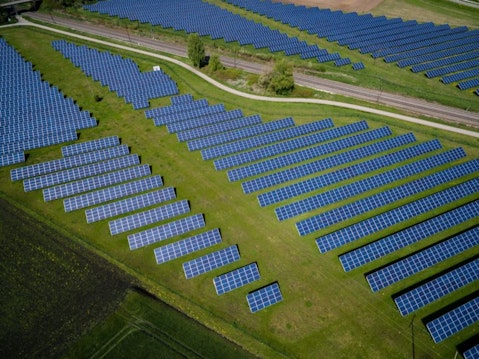
Photo by andreas gucklhorn on Unsplash
As we previously announced, we slowed our ingot capacity expansion this year, but accelerated our cell expansion plans. This reflects our views on the relative balance of supply and demand across the value chain. Please turn to Slide 9. Moving on to our battery storage business. First, I wanted to highlight the credible — the incredible achievements of our CSI energy storage team, which delivered 1.8-gigawatt hour of utility scale battery storage shipments over the past year. The team was formed right at the beginning of the global pandemic and grew from zero to over $400 million in revenue between 2020 and 2022. What’s more? Our team delivered some of the largest utility scale battery storage projects in the middle of the pandemic and was one of the very few players in the market that executed with almost no delays.
And every project we have delivered has been profitable, despite steep increases in key raw material prices. In fact, lithium carbonate prices went up by more than 10x over the period, although prices have recently started to come down. Battery storage is one of our long-term key strategic growth areas. Over the past several quarters, we have been investing in R&D and have successfully launched one of the most competitive utility scale battery storage products, the SolBank. As we transition from previously delivering a white label product to our own manufactured SolBank. 2023 is going to be a transition year for our battery storage shipments, especially considering the longer order fulfillment lead times for battery storage compared to solar.
This is why we expect flat deliveries year-over-year in 2023. However, we have very strong visibilities over our long-term growth. As of January 31, SolBank had over $1 billion in contracted revenue and a total pipeline of 23-gigawatt hour in our turnkey utility-scale storage business. We expect this to continue to grow over the long term as we further expand our commercial capabilities in this space. Please turn to the next slide. On the residential battery storage side, we have now officially launched our EP Cube products in the U.S., Europe and Japan. Shawn and I just came back from World Smart Energy Week in Tokyo after a very successful launch event last week. Last year, the Solar Power World editorial team picked the EP Cube as their favorite residential battery storage product.
This has been echoed by our customers given the EP Cube’s customizable and modular design, ability to be both DC and AC coupled, easy installation and incredibly beautiful design. Since the launch, we’ve been working closely with our distributors and the installer network, which we were able to leverage directly from our existing solar module channels. We started shipping in Q4 2022 and are targeting to achieve at least 100 million — 100-megawatt hour in 2023 in total. We’re building a strong brand and believe that the EP Cube is one of the best consumer battery storage products in the market which will help us strengthen our competitive advantage and market position in the business that has significant barriers to entry. The Global Energy system is undergoing significant change that impact how we think strategically about our market positioning, how value creation is defined with growing awareness of energy security and global efforts to decarbonize our economies through tools such as carbon pricing and other carbon neutrality initiatives the value proposition of our company and the industry would not look the same in the future.
Our focus is always on value creation. In the past, it may have been the PV systems only. But increasingly, it will be PV+ storage, even to PV+ storage, plus a much more efficient and intelligent integration systems to facilitate energy treaty. We seek to differentiate our business model so that we are always creating value for our customers. Now let me pass it on to Ismael. Ismael, please go ahead.
Ismael Guerrero: Thank you, Yan. Please turn to Slide 11. We achieved 2 gigawatts in project sales in 2022, $822 million in revenue and $161 million in gross profit. Our gross margin improved by 230 basis points year-over-year to 19.6%. As expected, was a smaller quarter from a project monetization standpoint due to the timing of project sales. Additionally, in Q4, we decided to hold on to more projects longer term in certain markets such as Europe, where we believe we can capture more value by being the long-term asset owner and operator. Next slide, please. During Q4 2022, we continue to focus on originating and developing larger and most valuable project global pipeline of solar and battery energy solace assets. As of January 31, our total pipeline stood at 25 gigawatts of solar and 47-gigawatt hours for battery storage projects.
Of this, we had 14 gigawatts of solar and 12 gigawatt hours of battery storage interconnections. We believe that clean energy assets ability to interconnect at low cost and at a reasonable timeframe will be one of the most important determinants of the value. This is a shift from the past, where the focus was mainly on projects contracted revenues or environmental permitting, both of which are still important, but interconnections will be absolutely critical. And this value will only increase over time as the world continues to decarbonize and grids become more congested as they continue to absorb more solar and wind energy. The fact that we already have 14 gigawatts of solar and 12 gigawatt hours of storage interconnections means that we are in a very strong position to deliver high-quality assets over the next few years.
Please turn to Slide 13. The other factor that differentiates Canadian Solar is that we are one of the few companies that can capture significant value through the entire project development cycle. We developed the vast majority of our pipeline from greenfield. Our capabilities expand all the way from initial site selection to permitting financing execution, operations and maintenance, and asset management. And we have had 14 years’ experience delivering nearly 9 gigawatts of solar power plants and 3 gigawatt hours of battery storage projects across six continents. These are literally hundreds of projects and the expertise we have amazed across all our major regions is truly unparalleled. Next slide, please. Longer term, as we’ve discussed on prior calls, our strategy is to retain greater asset ownership in select markets to increase the revenues generated through recurring income, such as power sales, operations and maintenance and asset management income.
We understand that our Global Energy business in its current form is difficult to forecast on a quarterly basis, given the lumpiness of our product sales and the difficulty to accurately time deal closings. And while we develop some of the most valuable solar and battery storage assets, the constant pressure to recycle capital quickly means that we may not sufficiently capture the value we create. So our plan is to hold on to certain assets for longer, where it makes sense from a risk and value creation standpoint. For example, we recently closed the first 30% sale of our Italian alternative investment fund. This vehicle will allow us to retain and operate assets over the longer term by partnering with lower cost of capital investment partners.
The strategic decision to keep more projects in Europe over the longer term was a factor in Q4 of slightly lower project sales. This way, we will be gradually moving from a spot sales business to a recurring revenue one, accounting for value creation and cash flow considerations. Now, let me pass it on to Huifeng, who will go through the financial results in greater detail. Huifeng, please go ahead.
Huifeng Chang: Thank you, Ismael. Please turn to Slide 15. In Q4, we achieved a 29% revenue growth year-over-year with $1.97 billion in revenue. Gross margin in Q4 was 17.7% at the higher end of our guidance of 16% to 18%. CSI Solar gross margins expanded by 10 basis points to 17.4%, while Global Energy gross margins were at a healthy 21.7%. Selling and distribution expenses declined by 24% sequentially even with our continued increase in shipping volumes. As Yan mentioned, shipping costs are finally back to a more normalized level. On the other hand, we are starting to see the ground transportation costs in different parts of the world are picking up slightly due to limited labor availability, but this is more than offset by the decline in shipping costs.
General and administrative expenses declined 13% sequentially due to OpEx efficiencies and lower impairment costs. Research and development expenses increased 15% sequentially driven by higher investments in our solar and battery storage R&D workshops. Put together, total operating expenses were down 22% in Q4 sequentially. This is 10.8% of total revenue, which is the lowest level since 2018, as the dynamics as Shawn mentioned in his introductory remarks, are starting to play out. Net foreign exchange and derivative loss in the fourth quarter was $15 million, partially reversing the $39 million gain we achieved in the third quarter. The loss was mainly driven by the strengthening of the euro and the Japanese yen against the U.S. dollar. Total net income was $99 million, with net income attributable to Canadian Solar shareholders at $78 million or diluted EPS of $1.11.
Now turning to the cash flow and the balance sheet. Next slide, please. For the full year of 2022, we generated approximately $920 million in operating cash and spent around $600 million in CapEx. We ended the period with healthy cash balance of $2 billion and a total net of $2.6 million. We further improved our leverage measure as net debt-to-EBITDA, excluding restricted cash, to 2.5x from 2.7x the prior quarter and 3.4x in Q4 of last year. For 2023, we expect CapEx to be approximately $1.5 billion as we support our capacity for this year and prepare for next year’s growth plans. This is significantly higher compared to our historical CapEx spending, but it reflects the much larger global scale of our business and favorable demand outlook, especially the U.S. market.
Over 25% of the CapEx will be financed by customer down-payments as we establish manufacturing capacity in the U.S. and expand our capacity in Southeast Asia, another 40% with internal cash generation and the remaining from debt financing. Now, let me turn the call back to Shawn, who will conclude with our guidance and the business outlook. Shawn, please go ahead.
Shawn Qu: Thanks, Huifeng. Let’s turn to Slide 17. For the first quarter of 2023, we expect solar module shipments by CSI Solar to be in the range of 5.9 to 6.2 gigawatts, including approximately 130 megawatts of solar module shipment to our Global Energy project. Total revenues are expected to be in the range of $1.6 billion to $1.8 billion as Q1 tends to be a seasonally smaller quarter. Gross margin is expected to be between 18% to 20%, reflecting the margin improvement from lower manufacturing costs. For the full year of 2023, we reiterate CSI Solar’s total solar module shipment guidance to be in the range of 30 to 35 gigawatt. CSI Solar’s battery storage shipments are expected to be between 1.8 to 2 gigawatt hour, reflecting this year’s transition from white label to our own manufactured products, as explained by Yan earlier.
Global Energy’s project sales are expected to be around 3 gigawatts, although we are currently revisiting some of our project sales forecast as we may want to hold on to more projects longer term. We also introduced revenue guidance for the full year 2023, which we expect to be in the range of $8.5 billion to $9.5 billion. We remain focused on profitable growth and investing in our long-term areas of competitive advantage. We believe this differentiates us as we build lasting value for our shareholders. With that, I would like to open the call for your questions. Operator?
See also 15 Best Stocks Under $10 To Buy Now and 20 Popular Investor Websites for Dividend Paying Stocks.
Q&A Session
Follow Canadian Solar Inc (NASDAQ:CSIQ)
Follow Canadian Solar Inc (NASDAQ:CSIQ)
Operator: And our first question is from the line of Colin Rusch with Oppenheimer.
Colin Rusch: Shawn, as you look at this business, you talked about the value creation and the value capture changing as well as the vertical integration that the company is planning. Can you talk a little bit about where you think gross margins end up over a multiyear period? Is this something where you guys can get to 28% to 30% gross margins? Or should we be thinking about kind of 25%, 26%?
Shawn Qu: That’s a very good question. Well, in the past, Canadian Solar’s gross margin had been in the 20% to 30% range. For example, from 2018 to 2020, our gross margin has pretty much every quarter about 20%. And then we had COVID and also the raw material cost increase not only happened to solar, but basically raw material for everything and the raw material information. So as I said in my part of this presentation, we think the cost started to decline, some of the raw material costs already started to decline and eventually will reach the bottom of the cost curve. And also the competition in the solar industry, just like for every industry, should somehow stabilize. And once it stabilizes, I do think that 20% to 30% is something we can hope for in mid- to long term.
Colin Rusch: That’s super helpful. And then as you look at retaining these projects, can you talk about the actual cash contribution once you’ve built the projects and refinance them? Is there going to be like an actual cash contribution here? Or are you going to be able to refi all your hard costs out and really just hold these equity positions?
Shawn Qu: Yes, I would like to ask Ismael to answer this question. Ismael?
Ismael Guerrero: Thank you, Shawn. We are still working on it on the long run, but initially, the intention is to start to move into recurring revenues as quick as we can. That’s the initial idea.
Colin Rusch: Okay. Maybe I’ll just take that offline and pass it on then. But the idea is that you guys are going to be able to hold a minimal part of the cash equity and actually just capture a significant amount of value down the road. But I’ll take that offline.
Operator: Our next question is from the line of Vikram Bagri with Citigroup.
Vikram Bagri: Can you talk about how the CapEx is being spent, whether it is being spent, split between expansions, whether vertical integration with the poly facilities in the spend? How much is being spent on expanding your capacity for TOPCon modules? Just trying to understand like where the capital will be spent and what the trajectory will be beyond ’23 and ’24? And also, if you can comment on how do you look at capital allocation internally? Sort of following up on the last question. When you look at the spending on vertical integration, expanding manufacturing capacity versus retaining higher portion of equity in existing projects, how does the ROIC compare? What do you think the ROIC will be in these investments longer term?
Shawn Qu: Yes, see, we now run the two business, the CSI Solar business and the project business we call Global Energy business group. We run these two groups independently. So they make their own decisions. So I guess that’s my answer to your second question. We don’t really compare therefore, make decisions of where to allocate the capital. The two business groups spend their own money. They have their own equity base. Now with that, I would like to have Yan to answer your first question, which is about CapEx, manufacturing CapEx and whether we are spending the CapEx money on TOPCon or vertical integration or upgrade, things like that.
